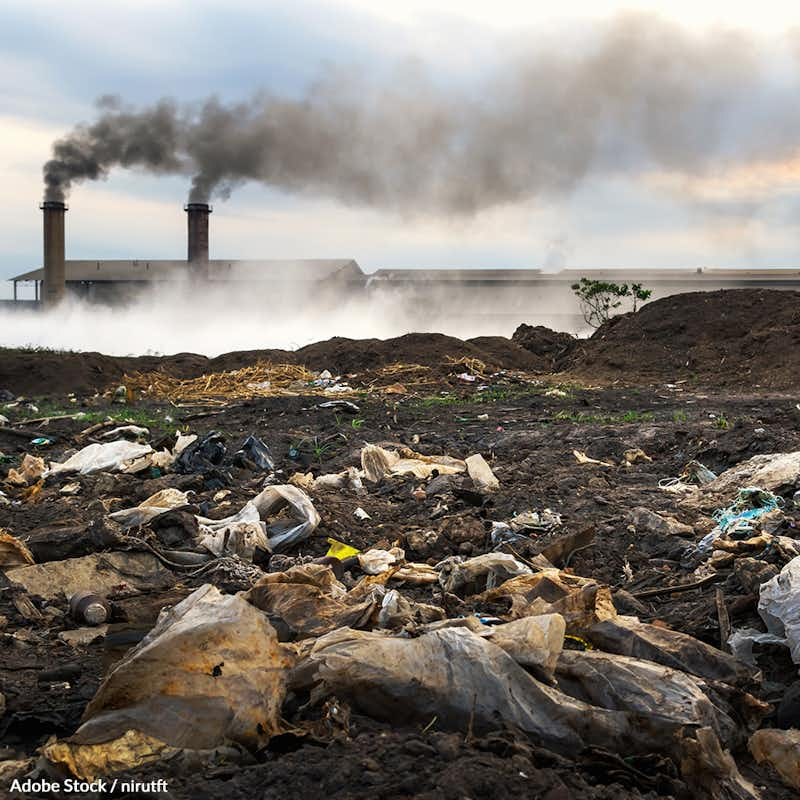Protect our Environment from Novel Pollutants
10,025 signatures toward our 30,000 Goal
Sponsor: The Rainforest Site
A new class of chemical compounds persist in the environment and are capable of causing serious disease.

Novel and anthropogenic chemicals are a new category of environmental contaminant that is predominantly unregulated and human-made. They come from pharmaceuticals, personal care products, and many other commercially available goods.
These compounds are found in air, soil, water, food, and human and animal tissues in trace concentrations. They persist in the environment and are capable of altering the physiology of target receptors, leading to serious disease in plants and animals1.
Methods including oxidation, photolysis, UV-degradation, nanofiltration, reverse osmosis, and adsorption have been used to remove these compounds out of water systems. While also costly and requiring experienced technicians to operate, some of these methods may result in generating even more toxic sludge or incomplete removal2.
In contrast, adsorption offers a low-cost alternative, easily used in developing countries where there is a dearth of advanced technologies, skilled personnel, and available capital, and adsorption appears to be the most broadly feasible pharmaceutical removal method2.
Adsorption technology has been extensively used for removing dyes from water systems for decades, and adsorption remediation methods are easily integrated with wastewater treatment plants3.
The largest chemical monitoring study to date was conducted in the Brazilian Amazon. The study found that chemical pollution can result in long-term effects for up to 50-80% of aquatic species next to urban areas.4.
In other regions, scientists have recorded drug-induced behavioral alterations in predatory fish and invertebrate prey. One study found that perch became more active while damselfly behavior was unaffected by novel toxins. However, prey consumption of novel pollutants can be an important exposure route as on average 46% of the pharmaceutical in ingested prey accumulated in the predator5.
This basically means we are already greatly underestimating the problem these novel pollutants cause.
The Toxic Substances Control Act of 1976 provides EPA with authority to require reporting, record-keeping and testing requirements, and restrictions relating to chemical substances and/or mixtures. TSCA addresses the production, importation, use, and disposal of specific chemicals including polychlorinated biphenyls (PCBs), asbestos, radon and lead-based paint6.
Help us bring an end to this assault on our environment and health. Sign the petition below and demand the EPA update its list of chemicals covered under the TSCA to include novel and anthropogenic chemicals, and encourage the use of safe and cost-effective adsorption technologies in their removal.
- Alok Bhandari, Rao Y. Surampalli, Craig D. Adams, Pascale Champagne, Say Kee Ong, R. D. Tyagi, and Tian Zhang, American Society of Civil Engineers (2009), "Contaminants of Emerging Environmental Concern."
- Manvendra Patel, Rahul Kumar, Kamal Kishor, Todd Mlsna, Charles U. Pittman Jr., and Dinesh Mohan, Chemical Reviews (4 March 2019), "Pharmaceuticals of Emerging Concern in Aquatic Systems: Chemistry, Occurrence, Effects, and Removal Methods."
- Yanbo Zhou, Jian Lu, Yi Zhou, Yongdi Liu, Environmental Pollution (16 May 2019), "Recent advances for dyes removal using novel adsorbents: A review."
- Andreu Rico, Rhaul de Oliveira, Gabriel Silva de Souza Nunes, Cristiana Rizzi, Sara Villa, Isabel López-Heras, Marco Vighi, Andrea Viviana Waichman, Environment International (October 2021), "Pharmaceuticals and other urban contaminants threaten Amazonian freshwater ecosystems."
- Tomas Brodin, Susanna Piovano, Jerker Fick, Jonatan Klaminder, Martina Heynen, and Micael Jonsson, Philosophical Transactions of the Royal Society B: Biological Sciences (19 November 2014), "Ecological effects of pharmaceuticals in aquatic systemsimpacts through behavioural alterations."
- United States Environmental Protection Agency (22 June 2016), "Summary of the Toxic Substances Control Act."
The Petition:
To the Administrator of the EPA,
Novel and anthropogenic chemicals from human-made products are becoming a serious threat to the environment and health of all Americans. These polutants persist in the environment and are capable of altering the physiology of target receptors, leading to serious disease in plants and animals.
Through scientific studies, chemical pollution was found to result in long-term effects for up to 50-80% of aquatic species next to urban areas, significantly contributes to a biodiversity loss in the region. In other regions, scientists have recorded drug-induced behavioral alterations in predatory fish and invertebrate prey.
Threats to flora and fauna will only worsen if these pollutants are not removed. Thankfully, scientific studies have also found a reliable and cost-effective option in adsorption technologies, which have been used for removing dyes from water systems for decades and are easily integrated with wastewater treatment plants.
I demand you update your list of chemicals covered under the Toxic Substances Control Act to include novel and anthropogenic chemicals found in pharmaceuticals, personal care products, antimicrobials and antibiotics, hormones, plasticizers, surfactants, fire retardants, pesticides, and nanoparticles.
I further demand you permit the use of safe and cost-effective adsorption technologies in the removal of novel and anthropogenic pollutants, as outlined in the Toxic Substances Control Act's Waste, Chemical and Cleanup Enforcement guidelines.
Sincerely,